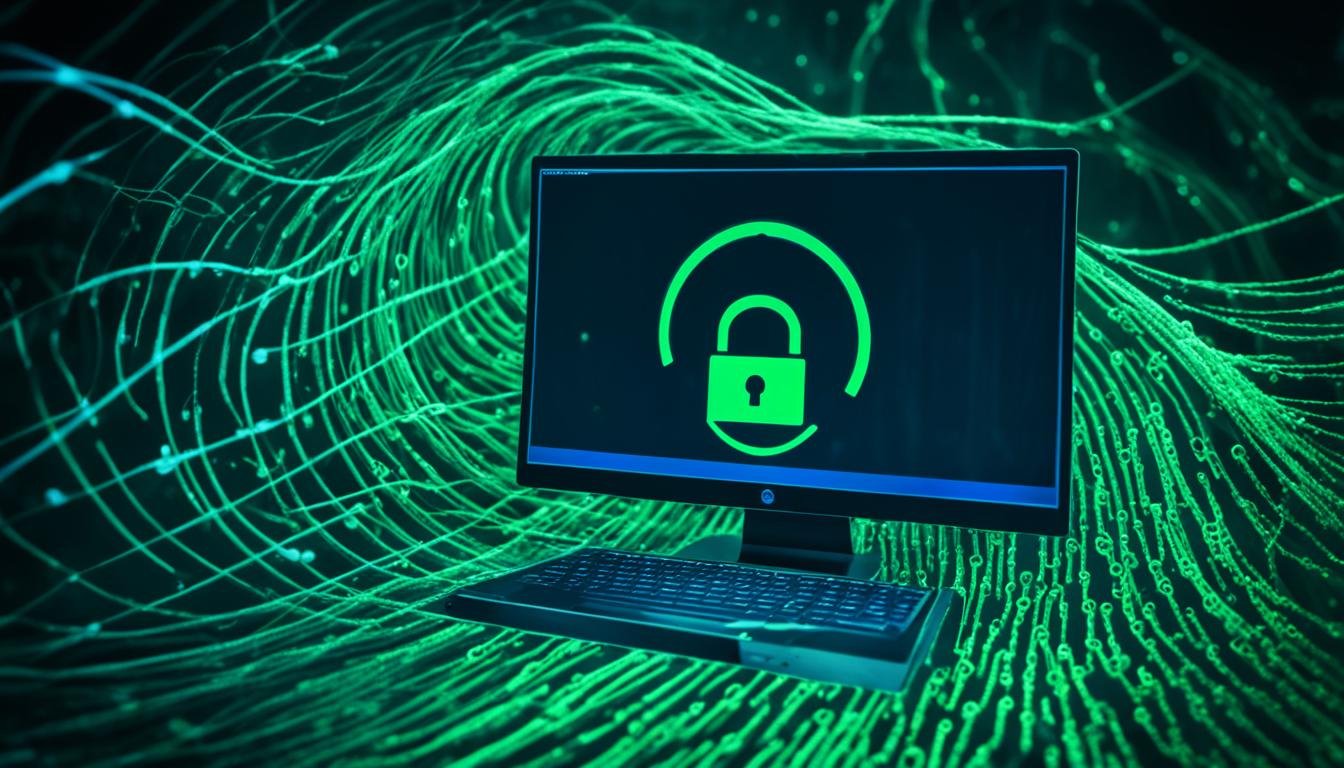Phishing and Ransomware: Strategies to combat common cyber threats.
Ransomware attacks have skyrocketed in recent years, threatening organizations worldwide. A report by [Data Breach Investigations Report](https://enterprise.verizon.com/resources/reports/dbir/) shows that ransomware made up 27% of all malware cases in 2020. This fact shows how big the problem is and why we need strong cybersecurity.
Ransomware attacks are now a major threat to both businesses and individuals. They are profitable because they are easy to do and hit some industries hard. Phishing, often through email scams, is a key way these attacks get to victims.
So, what can organizations do to fight these threats? We’ll look at ways to stop phishing and ransomware. We’ll give you tips and best practices to keep your data safe and protect your network from fraud.
Key Takeaways:
- Ransomware attacks made up 27% of malware cases in 2020, showing we need strong cybersecurity.
- Ransomware is getting more profitable because it’s easy and some industries are more vulnerable.
- Phishing, especially through email scams, is a main way ransomware gets to victims.
- To fight phishing and ransomware, we need to be proactive and use good cybersecurity strategies.
- Keeping software updated and using endpoint security are key parts of a good cybersecurity plan.
The Growing Epidemic of Ransomware Attacks
Ransomware is a malware that locks up a company’s IT systems until it gets a ransom. It has become more common, hitting businesses of all sizes and types. No one is safe from these cyber threats.
Ransomware attacks can really hurt a business, causing big problems and financial losses. Losing data can harm a company’s reputation and trust with customers.
Cyberattacks like ransomware have become more complex, using new ways to find weaknesses in systems. They often come through phishing emails, bad websites, or infected software. Once inside, they spread fast, encrypting important data until a ransom is paid.
These attacks don’t just cost money in ransoms. They also lead to more expenses for fixing things, restoring systems, and dealing with legal issues. Modern businesses are connected, so one attack can affect many others in the supply chain.
To fight ransomware, companies need to be proactive. This means having strong cybersecurity, like regular backups, secure networks, and training employees. A strong defense can lower the chance of getting hit by ransomware and lessen the damage.
It’s also key to keep up with the latest in cybersecurity and use threat intelligence to stay ahead. Working with cybersecurity experts and using top-notch security tools can help spot and stop ransomware attacks.
“Ransomware attacks are a big threat to businesses, putting their work, money, and reputation at risk. It’s important for companies to take steps now to protect against this growing problem.”
Ransomware attacks are becoming more common and need urgent action from all businesses. By focusing on cybersecurity and following best practices, companies can keep their data safe, protect their work, and fight against ransomware threats.
The Role of Phishing in Ransomware Attacks
Phishing is a big part of how ransomware spreads, making it a major threat to cybersecurity. Criminals use social engineering to trick people into putting ransomware on their devices. They send emails that look like they’re from trusted sources, making them hard to spot. As phishing gets better, the chance of getting hit by ransomware goes up.
Phishing emails try to trick people by looking real. Criminals fake email addresses and make the emails seem legit. They might pretend to be from big companies, banks, or even coworkers. This tricks people into doing things that spread malware.
“Phishing is the primary delivery vehicle for ransomware.”
Phishing works because many people don’t know how to spot fake emails. They might click on bad links or open attachments without thinking. This makes employees easy targets for hackers.
To fight phishing and ransomware, teaching people about cybersecurity is key. Training can help employees spot phishing emails and avoid falling into traps. This can lower the risk of getting hit by these attacks.
- Tell employees to check who sent emails and be wary of strange attachments.
- Tell them to check if emails are real by contacting the sender another way.
- Use email filters and anti-phishing tools to catch and block fake emails.
- Keep software up to date to fix security holes that hackers could use.
- Use more than one way to check who you are, and have strong passwords.
Teaching employees and improving security can reduce phishing and ransomware risks. It helps everyone make safer choices and protects personal and company data.
Common Phishing Techniques and Types
Phishing attacks are a big threat for companies today. They come in many forms, like spear phishing and business email compromise (BEC). Spear phishing is a targeted version of phishing that’s getting more complex.
Spear phishing targets specific people in a company. It uses fake emails that look real to get them to share sensitive info or click on bad links. Attackers do their homework to make emails seem legit. This makes it hard for employees to know they’re being tricked.
Business Email Compromise (BEC) is another phishing attack type. It tricks employees into doing things that help the attackers. This can be transferring money or sharing sensitive data.
Phishing emails can be different based on who they target and what they aim for. There’s corporate phishing, commercial phishing, and more. Each type goes after specific weaknesses in a company.
It’s key for companies to teach their staff about phishing tactics. Training can help employees spot phishing emails and act right. This lowers the chance of getting caught by these threats.
Best Practices for Phishing and Ransomware Protection
To protect your organization from phishing and ransomware, you need a strong defense strategy. Use these best practices to boost your cybersecurity and lower the risk of attacks.
1. Rethink Ransomware Protection Methods
Old ways of fighting ransomware might not work anymore. Use new security tools that use advanced technology to stop attacks fast.
2. Implement User Awareness Programs
Teach your employees how to spot phishing emails. Show them the dangers of opening suspicious links or sharing personal info. This can greatly lower the chance of getting attacked.
3. Establish Backup and Recovery Strategies
Back up important data and keep it safe offline. Also, have a plan to quickly get back up and running if you’re hit by an attack.
4. Manage Vulnerabilities and Patches
Keep your software and systems updated to stop ransomware and phishing. Use a good program to find and fix weak spots.
5. Enforce Access Controls
Use strong access controls like 2FA and least privilege to limit damage from attacks. Check and update who has access often.
6. Implement Content and Whitelist Filtering
Use filters to block bad emails and websites. This can stop phishing and ransomware attacks before they reach your users.
7. Configure Security Endpoints
Endpoints are key in stopping malware and attacks. Make sure all devices have the latest security software and are set up right.
8. Develop Incident Response Plans
Have a plan for when you get hit by an attack. Know who does what, how to communicate, and test the plan to make sure it works.
Adding these practices to your cybersecurity plan will help protect you from phishing and ransomware. Stay alert, keep up with threats, and improve your defenses to keep your digital stuff safe.
Importance of Regular Updates and Endpoint Security
Keeping systems and software up to date is key to stopping ransomware attacks. Attackers target outdated software to get into networks. Regular updates help keep security features sharp and block threats.
Updating systems is a big part of strong cybersecurity. Updates often fix vulnerabilities, making it tough for hackers to get in. By updating often, companies can stay ahead of threats.
Antivirus software is vital for protecting against malware. It checks files and programs for threats and removes them. Keeping antivirus software updated means it can spot the newest threats.
“Regular updates, including operating systems, web browsers, antivirus software, and firewalls, ensure that security features are current and can effectively detect and block threats.”
Firewalls protect a network by controlling what data goes in and out. They use rules to decide what traffic to let through. Keeping firewalls updated means they can handle the latest threats.
Network Segmentation
Network segmentation breaks a network into smaller parts. This makes it harder for ransomware to spread. By keeping sensitive data separate, a company can limit the damage from an attack. This method helps stop ransomware from moving across the network.
Endpoint security is key to fighting ransomware. Devices like laptops and phones are often where threats start. Using strong security on these devices helps protect them from attacks.
- Regular system updates
- Updated antivirus software
- Robust firewalls
- Network segmentation
- Comprehensive endpoint security
By doing these things and keeping software and systems updated, companies can lower the chance of getting hit by ransomware.
Conclusion
Phishing and ransomware attacks are big worries for all kinds of organizations. These threats keep changing, so we need strong defense plans. Using good cybersecurity steps like keeping software updated and teaching employees helps fight these threats. It’s key to have strong ways to protect against phishing and ransomware.
It’s not just important for companies but also for keeping our personal and business data safe. Cybercriminals are getting smarter, so we all need to stay alert and informed. Making sure to back up our data is also vital to lessen the damage if we get hit by an attack.
To fight phishing and ransomware, teaching and training are essential. This helps employees spot and report phishing tries. Working together is crucial to stay ahead of cybercriminals.
Stopping phishing and ransomware needs a strong plan. We must use good cybersecurity steps, update our systems, and teach employees about dangers. By acting early and focusing on cybersecurity, we can keep our data safe and keep our businesses running smoothly.
Source Links
- Phishing and Ransomware – How can you prevent these evolving threats? | Deloitte Luxembourg
- How to Prevent Ransomware Attacks: Top 10 Best Practices | UpGuard
- Protecting yourself from cyber attacks







